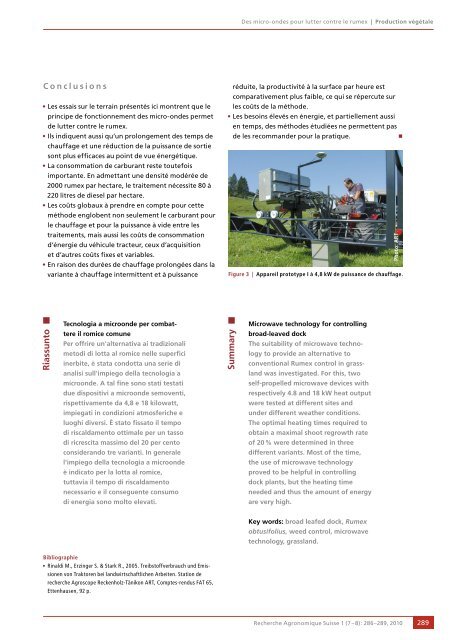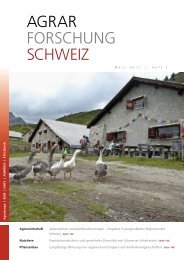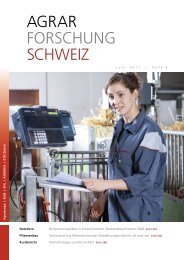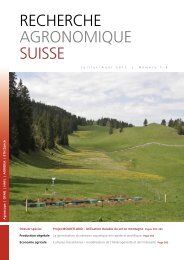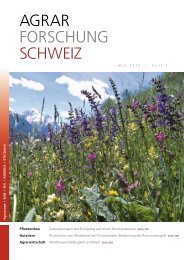Télécharger le PDF - Agrarforschung Schweiz
Télécharger le PDF - Agrarforschung Schweiz
Télécharger le PDF - Agrarforschung Schweiz
You also want an ePaper? Increase the reach of your titles
YUMPU automatically turns print PDFs into web optimized ePapers that Google loves.
Des micro-ondes pour lutter contre <strong>le</strong> rumex | Production végéta<strong>le</strong><br />
C o n c l u s i o n s<br />
••<br />
Les essais sur <strong>le</strong> terrain présentés ici montrent que <strong>le</strong><br />
principe de fonctionnement des micro-ondes permet<br />
de lutter contre <strong>le</strong> rumex.<br />
••<br />
Ils indiquent aussi qu’un prolongement des temps de<br />
chauffage et une réduction de la puissance de sortie<br />
sont plus efficaces au point de vue énergétique.<br />
••<br />
La consommation de carburant reste toutefois<br />
importante. En admettant une densité modérée de<br />
2000 rumex par hectare, <strong>le</strong> traitement nécessite 80 à<br />
220 litres de diesel par hectare.<br />
••<br />
Les coûts globaux à prendre en compte pour cette<br />
méthode englobent non seu<strong>le</strong>ment <strong>le</strong> carburant pour<br />
<strong>le</strong> chauffage et pour la puissance à vide entre <strong>le</strong>s<br />
traitements, mais aussi <strong>le</strong>s coûts de consommation<br />
d’énergie du véhicu<strong>le</strong> tracteur, ceux d’acquisition<br />
et d’autres coûts fixes et variab<strong>le</strong>s.<br />
••<br />
En raison des durées de chauffage prolongées dans la<br />
variante à chauffage intermittent et à puissance<br />
rédui te, la productivité à la surface par heure est<br />
compa rativement plus faib<strong>le</strong>, ce qui se répercute sur<br />
<strong>le</strong>s coûts de la méthode.<br />
••<br />
Les besoins é<strong>le</strong>vés en énergie, et partiel<strong>le</strong>ment aussi<br />
en temps, des méthodes étudiées ne permettent pas<br />
de <strong>le</strong>s recommander pour la pratique. <br />
Figure 3 | Appareil prototype I à 4,8 kW de puissance de chauffage.<br />
Photo: ART<br />
n<br />
Tecnologia a microonde per combat-<br />
Microwave technology for controlling<br />
Riassunto<br />
tere il romice comune<br />
Per offrire un'alternativa ai tradizionali<br />
metodi di lotta al romice nel<strong>le</strong> superfici<br />
inerbite, è stata condotta una serie di<br />
analisi sull'impiego della tecnologia a<br />
Summary<br />
broad-<strong>le</strong>aved dock<br />
The suitability of microwave technology<br />
to provide an alternative to<br />
conventional Rumex control in grassland<br />
was investigated. For this, two<br />
microonde. A tal fine sono stati testati<br />
self-propel<strong>le</strong>d microwave devices with<br />
due dispositivi a microonde semoventi,<br />
respectively 4.8 and 18 kW heat output<br />
rispettivamente da 4,8 e 18 kilowatt,<br />
were tested at different sites and<br />
impiegati in condizioni atmosferiche e<br />
under different weather conditions.<br />
luoghi diversi. È stato fissato il tempo<br />
The optimal heating times required to<br />
di riscaldamento ottima<strong>le</strong> per un tasso<br />
obtain a maximal shoot regrowth rate<br />
di ricrescita massimo del 20 per cento<br />
of 20 % were determined in three<br />
considerando tre varianti. In genera<strong>le</strong><br />
different variants. Most of the time,<br />
l'impiego della tecnologia a microonde<br />
the use of microwave technology<br />
è indicato per la lotta al romice,<br />
proved to be helpful in controlling<br />
tuttavia il tempo di riscaldamento<br />
dock plants, but the heating time<br />
necessario e il conseguente consumo<br />
needed and thus the amount of energy<br />
di energia sono molto e<strong>le</strong>vati.<br />
are very high.<br />
Key words: broad <strong>le</strong>afed dock, Rumex<br />
obtusifolius, weed control, microwave<br />
technology, grassland.<br />
Bibliographie<br />
▪▪<br />
Rinaldi M., Erzinger S. & Stark R., 2005. Treibstoffverbrauch und Emissionen<br />
von Traktoren bei landwirtschaftlichen Arbeiten. Station de<br />
recherche Agroscope Reckenholz-Tänikon ART, Comptes-rendus FAT 65,<br />
Ettenhausen, 92 p.<br />
Recherche Agronomique Suisse 1 (7 – 8): 286–289, 2010<br />
289


